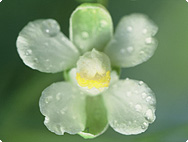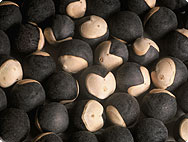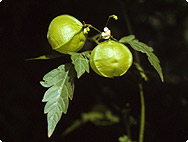A.Vogel search
When the internal search is activated, personal data such as your IP address is transmitted to our search engine Cludo. Data is thus transferred to a third country. Please click here if you want to display the internal search. You can find more information on data protection here: Privacy policy.
Cardiospermum halicacabum L.
Balloon vine
History

This rampant, foliage creeper grows in tropical regions. It was not known to ancient European naturopaths and probably first came to Europe in the Middle Ages as a decorative plant, but the exact circumstances of the plant’s introduction to Europe are not known. The earliest description of this plant is to be found in Leonhard Fuch’s “New Kreüterbuch” dated 1543. Although Fuchs was not familiar with the plant’s medicinal properties, he deemed it worthy of inclusion in his herbal so that others might be encouraged to consider the plant’s effectiveness. How farsighted of him! A beautiful illustration of the plant can be found in Bauhin’s 1731 revised version of Tabernaemontanus herbal.The plant was given its name in 1753 by botanist Carl von Linné. The generic name, Cardiospermum, meaning “heart seed”, refers to the plant’s pea-sized dark brown seeds which bear a typical white, heart-shaped spot on their surface. The species name “halicacabum” is derived from the Greek word meaning “salt barrel” and refers to the rotund fruits. The German word “Ballonrebe” (in English: balloon-vine) refers to these swollen-looking fruits.Balloon-vine was introduced to homeopathy by Willmar Schwabe in 1956, who, having collected the first examples of Cardiospermum in what was then Belgian-Congo, brought the plant to Germany and subsequently planted it. In its native land, this plant is not considered toxic; however, it can occasionally cause allergic reactions in certain sensitive patients. This effect gave naturopaths the impetus to study the plant’s usefulness for homeopathic remedies in the treatment of allergies.
Botanical characteristics

Balloon-vine is a perennial creeper; at its base, the plant’s stem is only approximately 3 mm thick, but it can reach a height of up to 2 metres. The stem forms internodes of between 5-10 cm in length. The grooved stem carries alternate double triad leaves, 3 to 5 cm long, which are hairless or covered in a soft down of hairs. The oval or lanceate leaves have a deeply serrated or lobated edge. The leaflets at the side are smaller. The tiny radiate flowers are white, standing in rolls on long flower stems of 5 to 10 cm in length. The perianth consists of 4 to 5 egg-shaped sepals and four petals with banner or wing-like fine combs. There are 8 anthers. Just beneath the flower stalks are 2 cm long tendrils, usually in pairs. The roughly 3 cm long green fruit is a blown up, almost entirely spherical capsule containing the characteristic seeds with their heart-shaped white markings. The plant is blooms in different periods, depending on where it grows. The Sapindaceae family are almost only to be found in tropical regions. The fruits of the species Sapindus contain saponins and foam in water, which is why they are used for washing in their native land. The flesh of the fruit is usually edible. The best known variety of Sapindaceae is the lychee (Litchi chinesis SONN.) Another medicinal plant in this family is Paullinia sorbilis MART., which supplies the drug “guarana” which contains caffeine.
Habitat

Balloon-vine was originally indigenous to the Bermudas, Florida and Texas. Nowadays it grows extensively in India, Africa and South America, where, in some places, it is regarded as a rampaging weed. Balloon-vine is cultivated in Switzerland and in southern Germany in wine-growing regions. It is not a hardy plant.
Preparation

A mother tincture is made from fresh above-ground parts of the plant when in bloom. A.Vogel/Bioforce grows the plant in organically controlled crops. Dilutions are prepared by shaking by hand.
A.Vogel Blog – Natural and Healthy
Inspiration for a healthy life!




